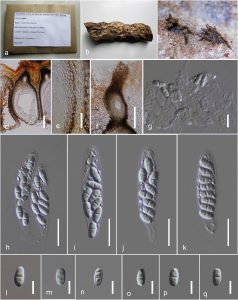Celoporthe dispersa Nakab.et al., in Nakab.et al., Stud. Mycol. 55: 261 (2006).
Pathogenic causing cankers on tree bark. Sexual morph: Ascostromata 100–400 μm high, 320–505 μm diam., semi-immersed in bark, recognizable by short, extending, umber, cylindrical perithecial necks, occasionally erumpent, limited, orange to umber ascostromatic tissue covering the tops of the perithecial bases. Stromatic tissue cinnamon and pseudoparenchymatous at the edges, prosenchymatous in the centre. Perithecia 100–300 μm diam., valsoid, 1–6 per stroma, bases immersed in the bark, black, globose to subglobose. Peridium 30–50 μm thick. Perithecial necks up to 50 μm long, 80–100 μm wide, black, periphysate, emerging through the stromatal surface, covered in umber stromatic tissue of textura porrecta, extended necks, 100–150 μm wide. Asci 23.5–29.5 × 5.5–7 μm, 8-spored, biseriate, unitunicate, free when mature, non-stipitate with a non-amyloid refractive ring, fusoid to ellipsoidal. Ascospores 6–8 × 2.5–3 μm hyaline, with one median septum, oblong-ellipsoidal, with rounded ends. Asexual morph: Stromatic tissue pseudoparenchymatous. Conidiomata 300–500 μm high, 200–1000 μm diam., eustromatic, superficial to slightly immersed, pulvinate to conical without necks, occasionally with a neck that is slightly attenuated, orange to scarlet when young, fuscous-black when mature, conidiomatal bases above the bark surface. Conidiomatal locules 100–550 μm diam., with even to convoluted inner surfaces, occasionally multilocular.
Conidiophores 12–17 × 1.5–2.5 μm, hyaline, branched irregularly at the base or above into cylindrical cells, with or without separating septa. Conidiogenous cells 1.5–3 μm wide, phialidic, determinate, apical or lateral on branches beneath a septum, cylindrical with or without attenuated apices, collarette and periclinal thickening inconspicuous.
Conidia 3–4 × 1–2.5 μm, hyaline, aseptate, oblong to cylindrical to ovoid, occasionally allantoid, exuded as bright luteous tendrils or droplets (description based on Gryzenhout et al. 2006c).
Material examined: SOUTH AFRICA, Limpopo Province, Tzaneen, Syzygium cordatum, 2003, M. Gryzenhout,
PREM58896, holotype.
Notes: Celoporthe is distinguished from other genera in Cryphonectriaceae based on characteristics of the asci,
conidiomata, conidiophores, conidia, paraphyses and growth in culture.
Fig. Celoporthe dispersa (PREM 58896). a, b Herbarium specimen. c Ascostromata on substrate. d Cross section of ascomata. e Peridium. f Cross section of ostiolar neck. g Parenchymatous cells. h–k Asci. l–q Ascospores. Scale bars: d = 100 μm, e = 25 μm, f = 50 μm, h–k = 10 μm, g, l–q = 5 μm.
Fig. Celoporthe dispersa (asexual morph; redrawn from Nakabonge et al. 2006). a Conidiomata. b Vertical cross section of conidiomata. c Conidiophores and conidia. Scale bars: a, b = 100 lm, c = 10 lm.


